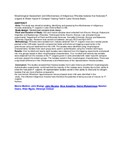| dc.contributor.author | Muthini, Morris | |
| dc.contributor.author | Maingi, John | |
| dc.contributor.author | Muoma, John | |
| dc.contributor.author | Amoding, Alice | |
| dc.contributor.author | Mukaminega, Dative | |
| dc.contributor.author | Osoro, Newton | |
| dc.contributor.author | Mgutu, Allan | |
| dc.contributor.author | Ombor, Omwoyo | |
| dc.date.accessioned | 2021-06-09T07:08:23Z | |
| dc.date.available | 2021-06-09T07:08:23Z | |
| dc.date.issued | 2014-01 | |
| dc.identifier.uri | https://doi.org/10.9734/BJAST/2014/5757 | |
| dc.identifier.uri | https://www.researchgate.net/publication/272759314_Morphological_Assessment_and_Effectiveness_of_Indigenous_Rhizobia_Isolates_that_Nodulate_P_vulgaris_in_Water_Hyacinth_Compost_Testing_Field_in_Lake_Victoria_Basin/references | |
| dc.identifier.uri | http://r-library.mmust.ac.ke/123456789/1647 | |
| dc.description.abstract | Aims: The study was aimed at isolating, identifying and assessing the effectiveness of indigenous rhizobia nodulating P. vulgaris in Lake Victoria Basin (LVB).
Study design: Randomized complete block design.
Place and Duration of Study: Soil and nodule samples were collected from Kisumu (Kenya); Kabanyolo (Uganda) and Nyabarongo (Rwanda). Field experiments: Kisumu (Kenya). Lab and greenhouse experiments: Department of Plant and Microbial Sciences Kenyatta University (Kenya) and Makerere University (Uganda). Research was carried out between January 2012 and April 2013.
Methodology: Rhizobia were isolated from nodules obtained from P. vulgaris (rose coco variety) plants planted in the LVB water hyacinth compost trial fields and whole soil trapping experiments in the greenhouse using soil obtained from the LVB. The isolates were identified using morphological characteristics. Isolates from each group were used in authentication using the infection technique.
Results: One hundred and twenty eight isolates were obtained from the trapping experiments and placed into nine groups based on their morphological characteristics. Four hundred and seventy two isolates were obtained from the nodules of the P. vulgaris grown in soils amended with water hyacinth compost and were placed into sixteen groups. The isolates varied in their morphological characteristics. There was a significant difference in the infectiveness and effectiveness of the representative rhizobia isolates.
Conclusion: The studies revealed that rhizobia isolates from Lake Victoria are different morphologically. Authentication experiments, confirmed that the majority of the isolates were rhizobia due to their ability to infect the host plant P. vulgaris. All representative isolates varied in their ability to infect and fix nitrogen. Isolates that are more effective compared to
the commercial Rhizobium leguminosarum biovar phaseoli strain 446 were identified in this
study. The effective indigenous rhizobia have therefore the potential of being sources of inocula for P. vulgaris. | en_US |
| dc.language.iso | en | en_US |
| dc.publisher | British Journal of Applied Science & Technology | en_US |
| dc.subject | Morphological, Assessment, Effectiveness, Indigenous, Rhizobia, Isolates, Nodulate P,vulgaris, Water Hyacinth, Compost, Testing | en_US |
| dc.title | Morphological Assessment and Effectiveness of Indigenous Rhizobia Isolates that Nodulate P. vulgaris in Water Hyacinth Compost Testing Field in Lake Victoria Basin | en_US |
| dc.type | Article | en_US |

